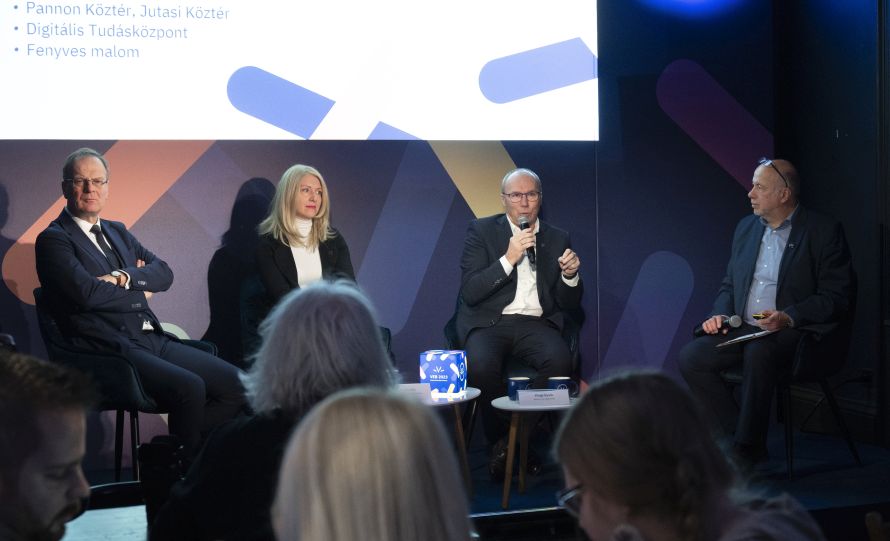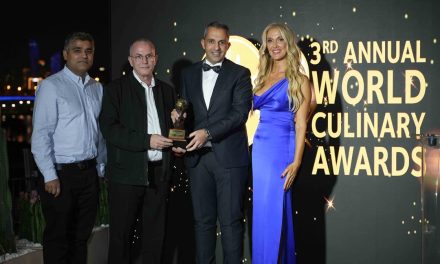In the wake of a successful European Capital of Culture 2023, the city’s leaders together with ECoC programme developers and organisers have set a twofold goal: on the one hand, to move Veszprém still further up in the ranking of European cities of similar size in terms of liveability by further boosting its cultural life, and on the other hand, to make the city and the region even more visible on the European cultural scene. In addition to last year’s visitor numbers and tourism results of the VEB2023 ECoC programme series, the press conference focused on how the city’s cultural life and infrastructure have been enriched – ways to continue the programmes and cultural vibrancy already started, to consolidate Veszprém and the Bakony-Balaton region as a cultural and creative industry region.
The Veszprém-Balaton 2023 European Capital of Culture programme in numbers: 1 year, 116 municipalities, more than 3,500 cultural events in 24 various genres. The success of the programme is demonstrated by the fact that more than 1,660,000 visitors came to Veszprém city centre during the year, which also shows that the Street Management programme with its aim of revitalising the city centre of Veszprém has successfully achieved its goal.80% of our programmes were free to attend. During the off-season period, the number of visitors and overnight stays increased significantly, successfully meeting another VEB2023 ECoC key objective, the extension of the tourism season.
The Cultural Year also had a positive impact on tourism, with a 17% rise in the number of international visitors to Veszprém compared to the previous year. As a result of the green commitment of the programme series, 38% of visitors came to our events in Veszprém by community transport, mainly owing to the joint efforts of Hungarian Railways, (MÁV) and VOLÁN national long-distance coach company, to promote sustainable transport. A discounted return ticket with a nominal price of of HUF 2023 was available from anywhere in the country, as well as a 24-hour ECoC regional day ticket. Services were complemented by a number of spectacular cultural programmes on trains.
An important result of the programme series is that 71 cultural infrastructure projects have been delivered (52 in Veszprém and the rest in the region), adding to the long-term vitality of the cultural life of the city and the region. Examples include ActiCity Dance and Movement Centre, home for ballet, folk dance and a dozen other movement arts; Foton Audiovisual Centre – not only an art cinema but also home for experimental visual arts in Veszprém; the soon-to-open Dungeon Museum exhibition to stimulate youth cultural tourism; the renovated old Jewish cemetery is a memorial to the people who played an important role in the city’s development, and soon-to-open CODE Digital Experience Centre is envisaged as a cutting-edge venue in Europe for 21st century immersive digital exhibition spaces.
Among the artistic events launched under the Veszprém-Balaton 2023 European Capital of Culture programme, Off-Season (fringe) literary festival was a great success. Balkan:MOST festival, building bridges between cultures, brought in massive audiences. Long Table Picnic saw thousands of people from the city and the region seated next to each other at a single one-and-a-half kilometre (!) festive table; a Blues Festival in the spring and a Jazz Festival in the autumn drew in crowds of fans. Gyárkert (Factory’ard) – an urban landscape sore transformed from a former furniture factory site into a cultural park – hosted over 70 concerts by Hungarian and world stars. The ECoC year also saw the strengthening of traditional Veszprém festivals such as VeszprémFest, Auer Festival, Street Music Festival, and the traditional Gizella Days.
Similarly, a number of arts festivals have been successfully launched and are expected to continue and grow in the region, including the Pajta (Barn) programme, aimed at helping local communities to have access to a greater selection and higher quality of culture, and the KultHáló (CultNet programme. So, an unusual density of good things continues to attract visitors to Veszprém and the Bakony-Balaton region after the ECoC year. Since the run-up years, the aim of the Veszprém-Balaton 2023 European Capital of Culture programme has been to transform the area, with Veszprém as its centre, into a creative-cultural region, not only in Hungary but also on a European level. The processes set in motion by the programme, such as cooperation between municipalities in the region, the expansion of cultural offer, and the building and strengthening of local communities, were not only the objectives of the European Year, but established the foundations for a much longer-term development in the life of the region. In 2024 and beyond, the region will continue its efforts to transform Veszprém, the Bakony and Lake Balaton into a tourist destination where there are countless cultural opportunities not only for visitors but also for locals, across a wide range of attractions, from sport to fine arts, music and gastronomy.
Minister of Public Administration and Regional Development Tibor Navracsics stressed that Veszprém and the region have a shared responsibility to continue their efforts and successfully use the results of the ECoC year to make Veszprém and the Bakony-Balaton region still better known: “The successful season has proven that we can very well take advantage of the opportunities, strengths and resources available to us. However, it is important to remember that more talent means more responsibility, which means we cannot fade back into obscurity. It is up to us to keep the collaboration, the new institutions and the new community spaces going.”
Mayor of Veszprém Gyula Porga noted that the results of the Cultural Year will directly and indirectly improve the quality of life in the city: “We will continue to work to deserve the attention and spotlight that we have received thanks to the year 2023. Our most important task is to turn our successes and achievements to the benefit of the people of Veszprém, thereby improving our liveability indicators. Every ECoC investment has created new value for us, which we will be proud to pass on to future generations. Our traditions have also been enriched and we will continue to nurture and enrich them so that we can proudly present an ever richer cultural offer.”
For Alíz Markovits, CEO of Bakony-Balaton 2023 Jsc., the organisation responsible for implementing the ECoC year, the absolute highlight has been the collaboration of 116 joined municipalities and the continuation of cultural events launched by the ECoC spirit. “The Veszprém-Balaton 2023 European Capital of Culture programme – which has been enlivening the everyday life of Veszprém and the Bakony-Balaton region, not just in 2023 but since 2020, in the lead-up years – is an exemplary and unique project in Europe, as it was not confined to the borders of a single city, but mobilised an entire region. Although the ECoC year has come to an end, many of last year’s successful events are set to continue this year, so it is worth keeping an eye on the cultural buzz that Veszprém and the Bakony-Balaton region have and continues to have.”















